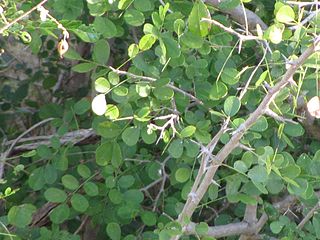
Podocarpus latifolius is a large evergreen tree up to 35 m high and 3 m trunk diameter, in the conifer family Podocarpaceae; it is the type species of the genus Podocarpus.

Dalbergia melanoxylon is a flowering plant in the family Fabaceae, native to seasonally dry regions of Africa from Senegal east to Eritrea and south to the north-eastern parts of South Africa. The tree is an important timber species in its native areas; it is used in the manufacture of musical instruments and fine furniture. Populations and genomic resources for genetic biodiversity maintenance in parts of its native range are threatened by overharvesting due to poor or absent conservation planning and by the species' low germination rates.

The conservation status of a group of organisms indicates whether the group still exists and how likely the group is to become extinct in the near future. Many factors are taken into account when assessing conservation status: not simply the number of individuals remaining, but the overall increase or decrease in the population over time, breeding success rates, and known threats. Various systems of conservation status exist and are in use at international, multi-country, national and local levels as well as for consumer use.

Avicennia marina, commonly known as grey mangrove or white mangrove, is a species of mangrove tree classified in the plant family Acanthaceae. As with other mangroves, it occurs in the intertidal zones of estuarine areas.

Leucadendron argenteum is an endangered plant species in the family Proteaceae, which is endemic to a small area of the Cape Peninsula, South Africa. Most grow in and around the city of Cape Town, but outlying populations exist near Somerset West (Silwerboomkloof), Paarl and Stellenbosch. It is a protected tree in South Africa.

Protea laurifolia, also known as the grey-leaf sugarbush, is a shrub from South Africa. It is native to the Cape Provinces of South Africa.
Tephrosia pondoensis is a species of legume in the family Fabaceae. It is found only in South Africa, where it is protected under the National Forest Act of 1998. The pondo poison pea is threatened by habitat loss.

Podocarpus elongatus, the Breede River yellowwood, is a species of conifer in the family Podocarpaceae. In contrast to other yellowwood species of southern Africa, Podocarpus elongatus often resembles an enormous, round, multi-stemmed bush in its habit. The Breede River yellowwood is a protected tree in South Africa.

Widdringtonia wallichii, Clanwilliam cedar or Clanwilliam cypress, previously Widdringtonia cedarbergensis is a species of Widdringtonia native to South Africa, where it is endemic to the Cederberg Mountains northeast of Cape Town in Western Cape Province. It is threatened by habitat loss and protected in South Africa under the National Forest Act of 1998.
Widdringtonia schwarzii is a species of Widdringtonia native to South Africa, where it is endemic to the Baviaanskloof and Kouga Mountains west of Port Elizabeth in Eastern Cape Province; it occurs on dry rocky slopes and crags at 600-1,200 m altitude. It is threatened by habitat loss, particularly by wildfire. The Willowmore cypress is a protected tree in South Africa.
Xenocalamus transvaalensis is a species of venomous rear-fanged snake in the family Lamprophiidae. The species is endemic to Africa. There are no subspecies that are recognized as being valid.
Cassipourea swaziensis is a species of plant in the Rhizophoraceae family. It is found in South Africa and Swaziland. It is threatened by habitat loss, and a protected tree in South Africa.
Ozoroa namaquensis is a species of plant in the family Anacardiaceae. It is found in Namibia and South Africa. It is threatened by habitat loss, and a protected tree in South Africa.

Protea comptonii, also known as saddleback sugarbush, is a smallish tree of the genus Protea in the family Proteaceae. It is found in South Africa and Eswatini.

Protea curvata is a species of plant in the family Proteaceae. It is endemic to South Africa, and a protected tree there.

Pappea capensis is a South African tree in the family Sapindaceae. It is the only species in the genus Pappea.

Ceriops tagal, commonly known as spurred mangrove or Indian mangrove, is a mangrove tree species in the family Rhizophoraceae. It is a protected tree in South Africa. The specific epithet tagal is a plant name from the Tagalog language.
Colubrina nicholsonii is a species of tree in the family Rhamnaceae. It is a protected species endemic to South Africa. The plant grows in subpopulations in isolated gorges, usually of 10-20 and less than 50 individuals overhanging water. It is estimated that there are no more than 1,000 individuals in the wild.

Pseudocordylus transvaalensis is a species of lizard in the family Cordylidae. It is a small lizard found in South Africa.















